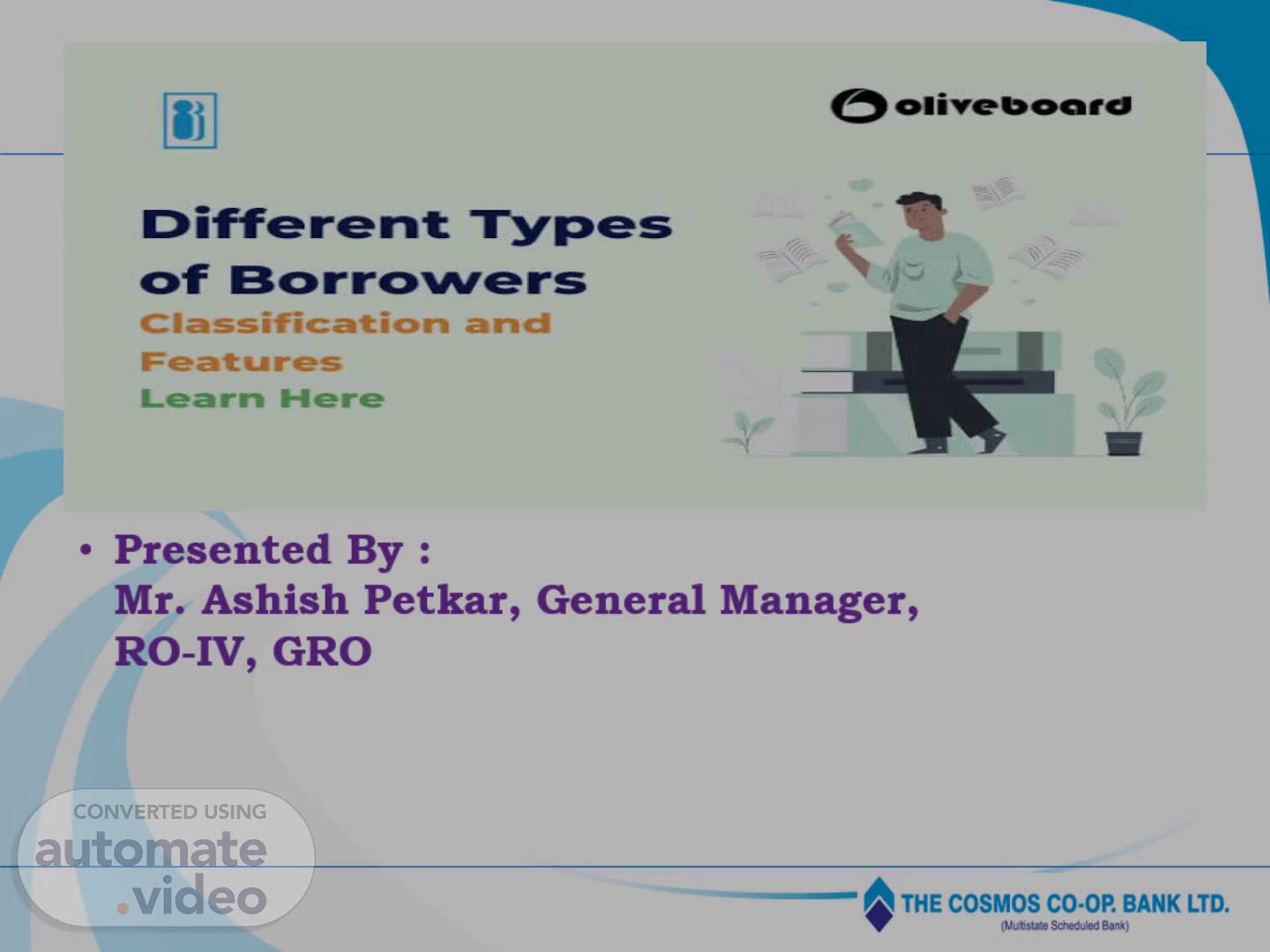Scene 1 (0s)
[Audio] Presented By : Mr. Ashish Petkar, General Manager, RO-IV, GRO.
Scene 2 (1s)
[Audio] Types of Borrower Banks typically categorize borrowers into several types of borrowers based on their creditworthiness, financial stability and loan requirements. Banks typically categorize borrowers into several types of borrowers based on their creditworthiness, financial stability and loan requirements..
Scene 3 (4s)
[Audio] Types of Borrower Common Types of borrowers Prime Borrowers Sub-Prime Borrowers Retail Borrowers Commercial Borrowers Corporate Borrowers Sovereign Borrowers High-Net-worth Borrowers Small and Medium Enterprise (SME) Borrowers Agricultural Borrowers Real Estate Borrowers.
Scene 4 (7s)
[Audio] Types of Borrower - Based on their Constitution Details of Borrower based on their Constitution are as below:- Individuals Proprietary Firm Partnership Firm Limited Liability Partnerships (LLPs) Private Limited Companies Public Limited Companies Trust Hindu Undivided Families (HUFs) Joint Liability Group (JLG) AOP – Association of Persons Co-operative Societies.
Scene 5 (16s)
[Audio] Individuals: Individual borrowers refer to natural persons who borrow money from lenders, such as banks, credit unions, or other financial institutions, for personal or household purposes. These categories include: Consumers Homeowners Investors.
Scene 6 (21s)
[Audio] Individuals: Key points for assessing Individual Borrowers: Income tax Returns of Individual borrowers/Salary slips/Form No.16 etc. to assess the repayment capacity. CIBIL report of Individual borrower. Saving/other loan account statements since inception. Net-worth statements. Employer/Residence verification Loan eligibility.
Scene 7 (27s)
[Audio] Proprietary Firm A proprietary firm, also known as a sole proprietorship, is a business owned and operated by one individual, known as the proprietor or sole proprietor. This the simplest and most common form of business ownership where: Single Ownership: One persona owns the business entirely. No legal separation: The business and owners are considered the same entity. Unlimited personal liability: The owner is personally responsible for all business debts and liabilities..
Scene 8 (32s)
[Audio] …. Continue No distinction between personal and business assets: The owners personal and business assets are not separate. No shareholders or partners: The owner has complete control and decision-making authority Easy to establish: Proprietary firms are relatively simple to set up and require minimum legal formalities. Taxation: Business income is taxed as personal income, and the owner reports business profits or losses on their individual tax return..
Scene 9 (37s)
[Audio] …. Continue Key points for assessing Proprietary Firm Borrowers Shop Act license/Registration Certificate of Business of proprietor/ GST/ PAN card/ Tax returns etc. The exposure to proprietary firm shall not exceed Rs. 300 Lakhs In case of limits exceeding Rs.300.00 lakhs, it is expected the proprietary firm may be converted into a partnership firm or limited liability company. Till such compliance is made, condition of co-borrower (close relative) is stipulated. However, in exceptional meritorious cases, the stipulation can be relaxed by competent authority. Market reference of the firm/individual..
Scene 10 (42s)
[Audio] Partnership Firm A partnership is a type of business structure where two or more individuals, known as partner, share ownership, profits and liabilities. The key characteristics of a partnership firm are: Multiple ownership: Two or more individuals own the business together. There must be an agreement between the Partners to do a business for gain. These agreements may be expressed or implied. Shared profits and losses: Partners share profits and losses in a predetermined ratio..
Scene 11 (47s)
[Audio] …. Continue Joint decision making: Partners have a say in business decision, and decisions are typically made collectively. Unlimited personal liability: Partners have unlimited personal liability, meaning their personal assets are at risk in case of business debts. Flexibility: Partnerships can be easily formed and dissolved. Limited Life: Partnerships can be dissolved upon death, bankruptcy or withdrawal of a partner. Capital Contribution: Partners contribute capital, skills or expertise to the business..
Scene 12 (52s)
[Audio] …. Continue No legal separation: The business and partners are considered the same entity. Taxation: Partners report their share of business profit or losses on their individual tax returns. Partnership firms include: General Partnerships: Equal partners with shared responsibility and liability. Limited Partnerships: Partners with limited liability and limited involvement in management..
Scene 13 (57s)
[Audio] Key Points for assessing Partnership Firms:- Registered Partnership Deed and copy of ROF (Registrar of Firms). Confirm borrowing clause is mentioned in Partnership Deed. Profit sharing ratio of partner/Director is more than 10%; then partner is known as beneficial owner and beneficial owner flag is entered in Finacle. All the partners of the Partnership firm shall stand as guarantor for the credit facilities to be sanctioned to Partnership firms. Details of their personal assets/liabilities shall be taken on record..
